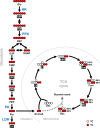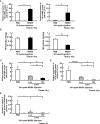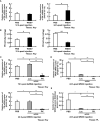White Spot Syndrome Virus Triggers a Glycolytic Pathway in Shrimp Immune Cells (Hemocytes) to Benefit Its Replication
- PMID: 35860260
- PMCID: PMC9289281
- DOI: 10.3389/fimmu.2022.901111
White Spot Syndrome Virus Triggers a Glycolytic Pathway in Shrimp Immune Cells (Hemocytes) to Benefit Its Replication
Abstract
White spot syndrome virus (WSSV) is the causative agent of a shrimp disease that inflicts in huge economic losses in shrimp-farming industry. WSSV triggers aerobic glycolysis in shrimp immune cells (hemocytes), but how this virus regulates glycolytic enzymes or pathway is yet to be characterized. Therefore, mRNA levels and activity of four important glycolytic enzymes, Hexokinase (HK), Phosphofructokinase (PFK), Pyruvate kinase (PK), and Lactate dehydrogenase (LDH), were measured in WSSV-infected shrimp hemocytes. Gene expression of HK and PFK, but not LDH or PK, was increased at the viral genome replication stage (12 hpi); furthermore, activity of these enzymes, except HK, was concurrently increased. However, there was no increased enzyme activity at the viral late stage (24 hpi). In vivo dsRNA silencing and glycolysis disruption by 2-DG further confirmed the role of glycolysis in virus replication. Based on tracing studies using stable isotope labeled glucose, glycolysis was activated at the viral genome replication stage, but not at the viral late stage. This study demonstrated that WSSV enhanced glycolysis by activating glycolytic enzyme at the viral genome replication stage, providing energy and biomolecules for virus replication.
Keywords: glycolysis; hexokinase; lactate dehydrogenase; phosphofructokinase; pyruvate kinase; stable isotope tracing; white shrimp; white spot syndrome virus.
Copyright © 2022 Ng, Lee, Liu, Tung, He and Wang.
Conflict of interest statement
The authors declare that the research was conducted in the absence of any commercial or financial relationships that could be construed as a potential conflict of interest.
Figures







Similar articles
-
Hypoxia inducible factor -1 regulates WSSV-induced glycolytic genes in the white shrimp Litopenaeus vannamei.Fish Shellfish Immunol. 2019 Sep;92:165-171. doi: 10.1016/j.fsi.2019.05.040. Epub 2019 May 27. Fish Shellfish Immunol. 2019. PMID: 31146006
-
Glutamine Metabolism in Both the Oxidative and Reductive Directions Is Triggered in Shrimp Immune Cells (Hemocytes) at the WSSV Genome Replication Stage to Benefit Virus Replication.Front Immunol. 2019 Sep 4;10:2102. doi: 10.3389/fimmu.2019.02102. eCollection 2019. Front Immunol. 2019. PMID: 31555294 Free PMC article.
-
White spot syndrome virus induces metabolic changes resembling the warburg effect in shrimp hemocytes in the early stage of infection.J Virol. 2011 Dec;85(24):12919-28. doi: 10.1128/JVI.05385-11. Epub 2011 Oct 5. J Virol. 2011. PMID: 21976644 Free PMC article.
-
Recent insights into host-pathogen interaction in white spot syndrome virus infected penaeid shrimp.J Fish Dis. 2015 Jul;38(7):599-612. doi: 10.1111/jfd.12279. Epub 2014 Jun 23. J Fish Dis. 2015. PMID: 24953507 Review.
-
The determinants of metabolic discrepancies in aerobic glycolysis: Providing potential targets for breast cancer treatment.Biochimie. 2024 May;220:107-121. doi: 10.1016/j.biochi.2024.01.003. Epub 2024 Jan 4. Biochimie. 2024. PMID: 38184121 Review.
Cited by
-
Transcriptomic variations associated with salinity stress in Penaeus indicus.Mol Biol Rep. 2023 Nov;50(11):9295-9306. doi: 10.1007/s11033-023-08824-4. Epub 2023 Oct 9. Mol Biol Rep. 2023. PMID: 37812353
-
Experimental Infection Models and Their Usefulness for White Spot Syndrome Virus (WSSV) Research in Shrimp.Viruses. 2024 May 20;16(5):813. doi: 10.3390/v16050813. Viruses. 2024. PMID: 38793694 Free PMC article. Review.
-
Mitochondrial Dysfunction and Metabolic Disturbances Induced by Viral Infections.Cells. 2024 Oct 29;13(21):1789. doi: 10.3390/cells13211789. Cells. 2024. PMID: 39513896 Free PMC article. Review.
-
A Novel Hemocyte-Specific Small Protein Participates in White Spot Syndrome Virus Infection via Binding to Viral Envelope Protein.Viruses. 2023 Jan 13;15(1):227. doi: 10.3390/v15010227. Viruses. 2023. PMID: 36680266 Free PMC article.
-
Coxsackievirus B3 infection induces glycolysis to facilitate viral replication.Front Microbiol. 2022 Dec 9;13:962766. doi: 10.3389/fmicb.2022.962766. eCollection 2022. Front Microbiol. 2022. PMID: 36569097 Free PMC article.
References
Publication types
MeSH terms
Substances
LinkOut - more resources
Full Text Sources

